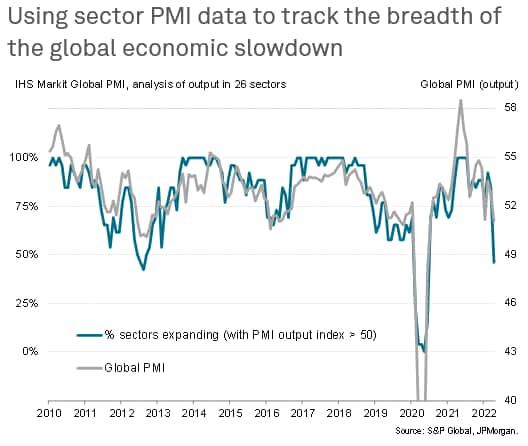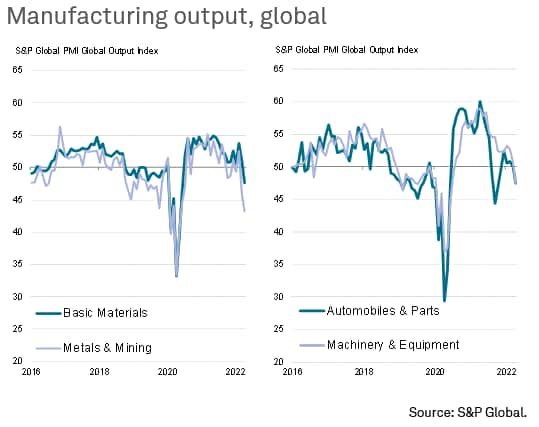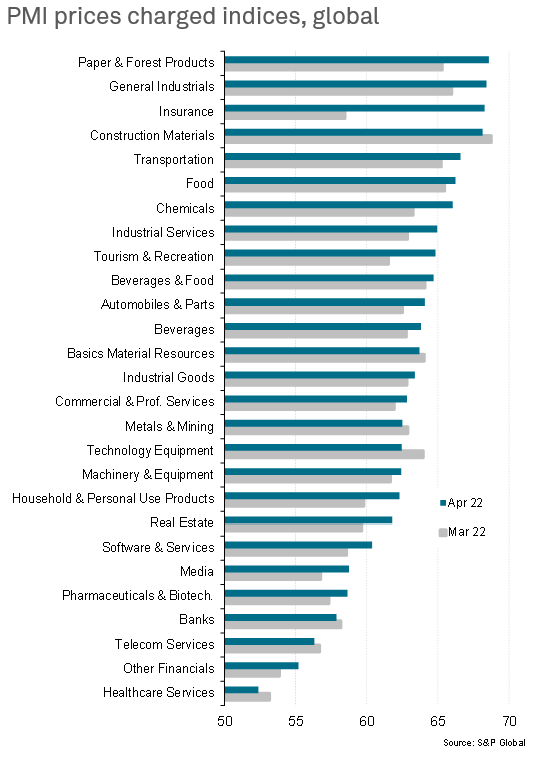Economic downturn spreads as more sectors report falling output and record price rises
Detail sector PMI data compiled by S&P Global, derived from
information provided by panels of over 30,000 companies in 45
countries, revealed a broadening of the global economic slowdown in
April. With the exception of the downturn seen in early 2020 during
the initial phase of the pandemic, April saw more sectors reporting
falling output than at any time since 2012.
With the Ukraine war ongoing and mainland China locking down
some of its major cities to fight the Omicron variant of COVID-19,
supply chain disruptions have increased, damaging vast swathes of
the global manufacturing economy, while price pressures have
intensified, eroding spending power.
While growth outside of China has shown some encouraging
resilience, losing only marginal momentum in April on average, this
can be linked to resurgent spending on consumer services amid to
loosened COVID-19 restrictions. However, demand for consumer goods
has almost stalled as household spending is diverted to services,
suggesting there is a risk that the global economy is reliant on a
potentially short-lived rebound in consumer service spending to
support sustained growth in the coming months.
Prices are meanwhile rising for all goods and services, though
of particular concern is a record rise in food prices amid falling
food production, which is likely to add to the global cost of
living crisis.
Output growth reliant on consumer
services
April saw the weakest pace of global economic growth since the
initial pandemic lockdowns in early 2020, according to the JPMorgan
Global Manufacturing Purchasing Managers’ Index™ (PMI™). The PMI,
compiled by S&P Global, fell from 52.7 in March to 51.0 in
April, signalling only a modest expansion of output.
The expansion was largely reliant on a surge in consumer
services activity, in turn attributable to an easing of COVID-19
containment measures on average globally during April. Output of
the consumer services industries rose worldwide at a rate not
exceeded since July of last year, driven by the steepest rise in
demand for nine months. Excluding prior pandemic growth spurts as
economies relaxed COVID-19 restrictions, the latest jump in
consumer services activity was the strongest since data were first
available in 2009.
In contrast, consumer goods manufacturers felt the pinch, as
household spending was diverted to services, reporting only a
modest expansion and the weakest performance since June 2020. New
orders placed for consumer goods likewise came close to stalling,
with companies often also reporting that higher prices were
deterring customers.
Downturn spreads to 14 sectors from just four in
March
Looking into the PMI data at a more detailed sector level, some
14 of the 26 sectors covered by the PMIs reported falling output in
April, up sharply from just four in March. The steepest declines
were seen in basic material manufacturing sectors, including
sustained downturns in mining & metals and basic materials
resources, as well as renewed downturns for construction materials
and industrial goods, often linked to deteriorating supply
chains.
Worsening supply chain delays meanwhile contributed to renewed
output falls for autos & parts and machinery & equipment
manufacturing.
The service sector slowdown was led by the first drop in global
real estate activity since May 2020, though banking services,
transportation and healthcare services all also declined.
Growth rates varied markedly among the 12 sectors reporting
output growth in April, ranging from sustained near-record growth
in ‘other financials’ and reviving expansions for media and tourism
& recreation, to near-stalled output of household products.
Record price rises seen in half of all
sectors
Selling prices meanwhile rose in all 26 sectors during April,
with rates of inflation accelerating in all but six. Around half of
all sectors reported unprecedented rates of increase. In the
service sector, these included transportation, commercial &
professional services, industrial services, insurance, real estate,
‘other’ financials, media and tourism & recreation. In
manufacturing, new record selling price increases were reported for
autos & parts, general industrials and food & drink.
Food prices surge at record pace amid falling
production
The record rise in food prices is a particular concern,
especially given that that the sector has also reported falling
output continually now for three months, with the worsening trend
linked to the Ukraine war. The growing scarcity of food and
associated price rises, combined with persistent elevated energy
prices, threatens to exacerbate the global cost of living crisis,
tending to hit the poorest the hardest.
Outlook
The broadening economic malaise is being triggered by the
lockdowns in China and Ukraine war, both of which are exacerbating
existing pandemic-related supply chain disruptions and price rises.
Whether more sectors fall into decline depends on how long these
two headwinds persist for, but is also a function of how well
spending on consumer services can be sustained amid the
intensifying cost of living crisis and growing concerns about the
economic outlook.
Chris Williamson, Chief Business Economist, S&P
Global Market Intelligence
Tel: +44 207 260 2329
© 2022, IHS Markit Inc. All rights reserved. Reproduction in whole
or in part without permission is prohibited.
Purchasing Managers’ Index™ (PMI™) data are compiled by IHS Markit for more than 40 economies worldwide. The monthly data are derived from surveys of senior executives at private sector companies, and are available only via subscription. The PMI dataset features a headline number, which indicates the overall health of an economy, and sub-indices, which provide insights into other key economic drivers such as GDP, inflation, exports, capacity utilization, employment and inventories. The PMI data are used by financial and corporate professionals to better understand where economies and markets are headed, and to uncover opportunities.
Learn how to access and receive PMI data
This article was published by S&P Global Market Intelligence and not by S&P Global Ratings, which is a separately managed division of S&P Global.
[ad_2]
Source link











